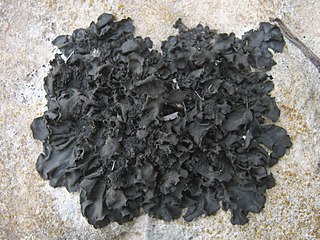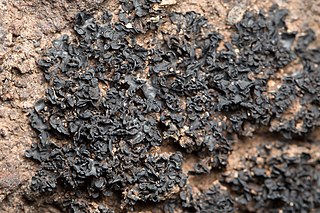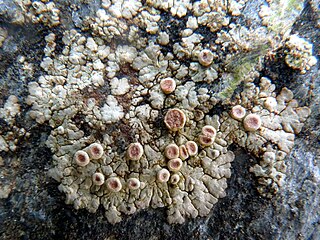
Pioneer species are hardy species that are the first to colonize barren environments or previously biodiverse steady-state ecosystems that have been disrupted, such as by wildfire.

Parmelia is a genus of medium to large foliose lichens. It has a global distribution, extending from the Arctic to the Antarctic continent but concentrated in temperate regions. There are about 40 species in Parmelia. In recent decades, the once large genus Parmelia has been divided into a number of smaller genera according to thallus morphology and phylogenetic relatedness.

The Parmeliaceae is a large and diverse family of Lecanoromycetes. With over 2700 species in 71 genera, it is the largest family of lichen-forming fungi. The most speciose genera in the family are the well-known groups: Xanthoparmelia, Usnea, Parmotrema, and Hypotrachyna.

Rhizocarpon geographicum is a species of lichen, which grows on rocks in mountainous areas of low air pollution. Each lichen is a flat patch bordered by a black line of fungal hyphae. These patches grow adjacent to each other, leading to the appearance of a map or a patchwork field.

Collema is a genus of lichens in the family Collemataceae. The photobiont is the cyanobacterium genus Nostoc. Species in this genus typically grow on nutrient-rich bark or somewhat siliceous or calcareous rocks in humid environments.

The Lichinaceae are a family of ascomycete fungi. Most species are lichenized with cyanobacteria, and have a distribution largely in temperate regions.

Sticta is a genus of lichens in the family Peltigeraceae. The genus has a widespread distribution, especially in tropical areas, and includes about 114 species. These lichens have a leafy appearance, and are colored brown or black. Sticta species with cyanobacteria as photobionts can fix nitrogen from the atmosphere, and due to their relative abundance and high turnover, they contribute appreciably to the rainforest ecosystem. They are commonly called spotted felt lichens.

Placopsis is a genus of lichenized fungi in the family Trapeliaceae.
Gymnoderma is a genus of lichen-forming fungi in the family Cladoniaceae. It has three species. The genus was circumscribed by Finnish botanist William Nylander in 1860. Nylander assigned Gymnoderma coccocarpum as the type species in 1869; this species was originally collected from the Himalayas. It occurs throughout southeastern Asia.

Pannaria is a genus of lichen-forming fungi in the family Pannariaceae. The widespread genus contains an estimated 51 species, found primarily in tropical regions.
Sarcopyrenia is a genus of lichenicolous (lichen-dwelling) fungi. It has 11 species. It is the only genus in Sarcopyreniaceae, a family in the order Verrucariales. Sarcopyrenia was circumscribed by Finnish lichenologist William Nylander in 1858, with Sarcopyrenia gibba assigned as the type species. Sarcopyreniaceae is one of the few families composed entirely of lichenicolous fungi.
Lichinodium is a genus of filamentous lichens. It is the only genus in the family Lichinodiaceae, itself the only member of the order Lichinodiales. Lichinodium has four species. Previously considered part of the class Lichinomycetes, molecular phylogenetic analysis revealed that Lichinodium represents a unique lineage in the Leotiomycetes—the first known group of lichen-forming fungi in this class.

Melaspilea is a genus of lichen-forming and lichenicolous fungi in the family Melaspileaceae. The genus was circumscribed by Finnish lichenologist William Nylander in 1857.

Xylographaceae is a family of lichen-forming fungi in the order Baeomycetales. It contains four genera and 25 species.

Parmelia fraudans is a species of foliose lichen in the family Parmeliaceae. It is found in Europe and North America, where it grows on rocks.
Pyrenidium is a genus of lichenicolous (lichen-dwelling) fungi. It is the only genus in the family Pyrenidiaceae. It has 13 species.

Xanthocarpia crenulatella is a species of saxicolous (rock-dwelling), crustose lichen in the family Teloschistaceae.

Athallia scopularis is a species of saxicolous (rock-dwelling), crustose lichen in the family Teloschistaceae. It was first formally described by Finnish lichenologist William Nylander in 1883 as a member of the genus Lecanora. After having been shuffled to several genera in its taxonomic history, it was transferred to the genus Athallia in 2013 following a molecular phylogenetics-led restructuring of the Teloschistaceae. This lichen grows on sun-lit seaside siliceous rocks, particularly those covered with guano from resting birds. It has been recorded from the Atlantic coasts of North America, Northern Europe, and Greenland.













